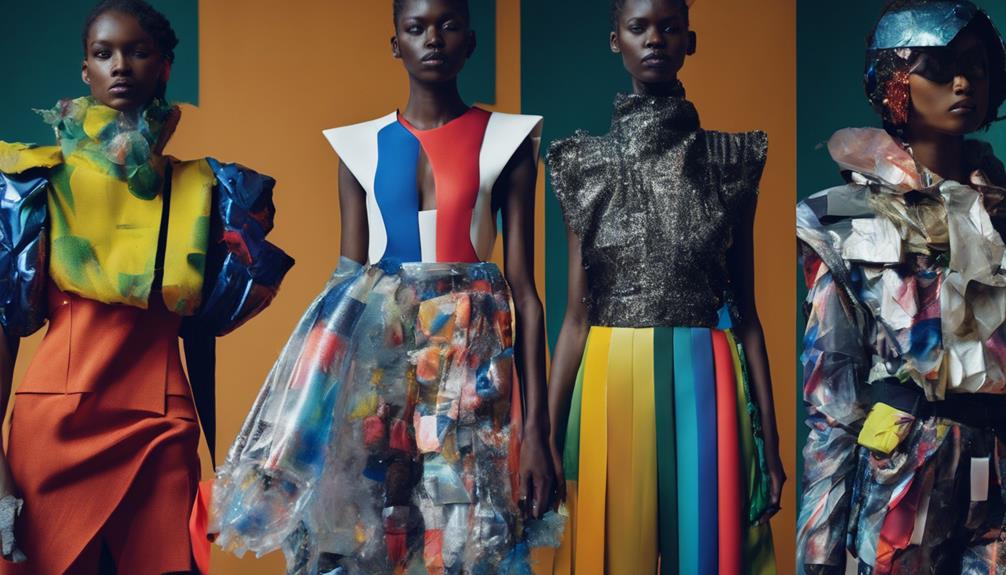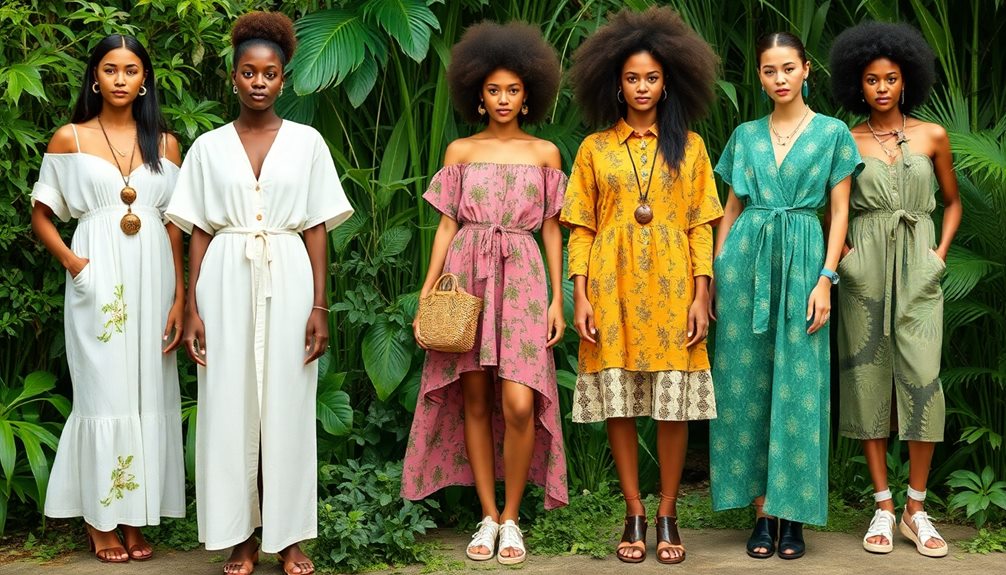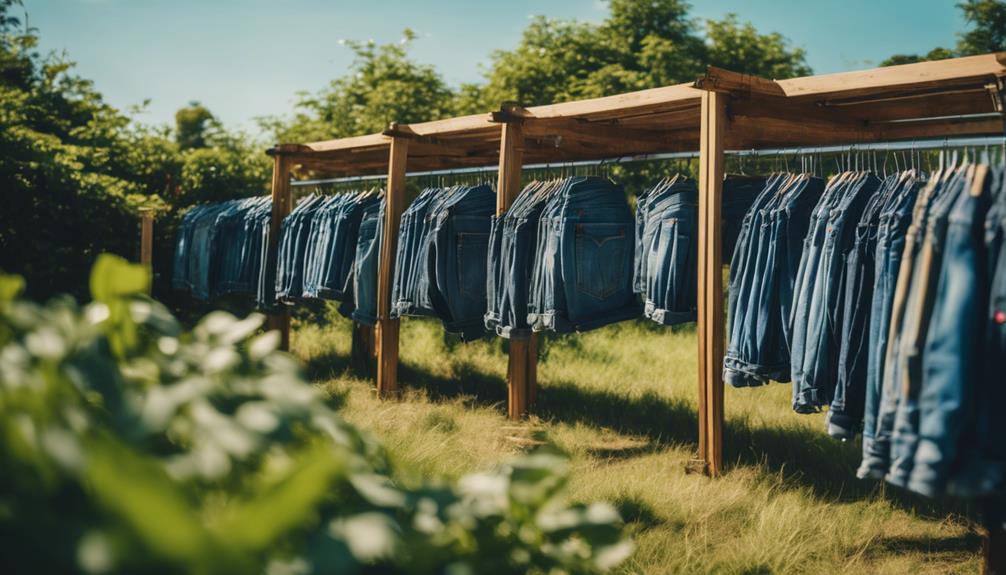The text rephrased: Sustainable fashion is without a doubt the future, albeit a complicated one. Many brands claim to follow eco-friendly practices, yet the actual progress made remains minimal. The industry is a significant polluter, with fast fashion habits still prevalent. While innovations like alternative materials show promise, they often do not address underlying issues. Government regulations are crucial for ensuring accountability. As consumers, your choices have an impact; supporting truly sustainable brands can combat greenwashing. Thrift shopping and circular economy practices are gaining popularity. Interested in how these factors are interconnected and what can be done? The details may surprise you.
Key Takeaways
- Sustainable fashion faces significant challenges, with only minimal progress made in 25 years despite growing consumer awareness and demand for transparency.
- Current practices, including recycling and rental models, often fail to address core issues of overconsumption and resource depletion.
- Genuine sustainability requires systemic change, necessitating collaboration among brands, consumers, and regulators to transform production and consumption practices.
- Government regulation is crucial, with frameworks like the Fabric Act set to combat greenwashing and enforce higher sustainability standards in the industry.
Industry Claims Vs. Reality
Despite the fashion industry's claims of sustainability, the reality shows that its environmental impact has barely budged in the last 25 years. You might think that brands are genuinely committed to sustainable practices, but the numbers tell a different story. The fashion industry contributes to 20% of industrial water pollution and 10% of global carbon emissions, largely due to its reliance on non-biodegradable, petroleum-based materials. Each year, over 11 million tons of textiles end up in landfills, highlighting the stark contrast between what you're told and what's actually happening.
Consumer demand for more sustainable options often leads to a misunderstanding of what sustainability truly means. The notion that ‘less unsustainable' practices equate to genuine sustainability is misleading. Every apparel brand has an environmental impact that can't simply be minimized.
To address these issues effectively, regulatory intervention is becoming increasingly necessary. Market-based solutions alone have failed to hold companies accountable for their negative environmental practices. Stricter frameworks for sustainable practices are essential to drive real change in an industry that's still struggling to align its claims with the actual reality.
Innovations and Their Shortcomings

While fashion brands tout innovations like bio-based materials and recycling programs, their actual impact on reducing environmental harm remains minimal. Most products are still made from non-biodegradable materials, and business models marketed as sustainable, like rental and resale, often fail to address the root causes of environmental degradation.
| Innovation Type | Shortcoming |
|---|---|
| Bio-based materials | Limited use; most products remain unsustainable |
| Recycling programs | Questionable overall impact on waste |
| Rental and resale models | Don't tackle core issues of consumption |
| Technology in production | Brands hesitant to fully commit due to perceived risks |
The misconception that sustainability exists on a spectrum confuses consumers, leading you to believe that 'less unsustainable' practices are equivalent to real sustainability. This undermines genuine efforts for systemic change. In addition, consumer behavior doesn't always align with the sustainability claims of brands, highlighting the need for a more thorough approach to reduce the environmental impact of fashion. True innovations in production processes and a shift in consumer attitudes are essential for achieving real sustainable fashion.
The Role of Government Regulation

Government regulation plays an essential role in holding the fashion industry accountable for its environmental impact.
By enforcing sustainable practices through measures like the Fabric Act, you can guarantee brands adhere to higher standards.
A strong regulatory framework could compel companies to comply and ultimately shift towards more sustainable operations.
Accountability for Environmental Impact
Holding fashion companies accountable for their environmental impact requires strong government regulation, as market solutions alone haven't tackled sustainability effectively. Regulatory frameworks are essential to enforce sustainable practices, ensuring companies internalize the costs of their environmental effects. In 2024, we can expect stricter regulations aimed at combating misleading sustainability claims and enhancing transparency in the industry.
Consider the following table that highlights the potential outcomes of effective regulation:
| Aspect | Current Situation | With Strong Regulation |
|---|---|---|
| Environmental Impact | High pollution levels | Reduced emissions |
| Accountability | Minimal consequences | Clear penalties for violations |
| Transparency | Misleading claims | Verified sustainability claims |
The introduction of bills like the Fabric Act emphasizes the need for accountability regarding labor practices and environmental impacts of manufacturing partners. Increased scrutiny from regulators and the public will push brands toward more responsible and sustainable practices, ultimately shaping a future where sustainable fashion isn't just a trend but a standard. It's time for the fashion industry to embrace this change.
Enforcing Sustainable Practices
To guarantee sustainable practices in the fashion industry, robust government regulation is vital for compelling brands to take responsibility for their environmental impact. As market-based solutions have often fallen short, government intervention becomes essential for holding fashion companies accountable. Proposed regulatory frameworks, like carbon taxes, would force these brands to internalize the costs associated with their negative environmental impacts, promoting genuine sustainability.
Recent legal challenges against major brands over misleading sustainability claims highlight the urgent need for clearer regulations. With stricter regulations anticipated in 2024, the focus will be on standardizing definitions for environmental terms, enhancing transparency in sustainability claims made by companies. This shift aims to build trust among consumers and guarantee that fashion companies can no longer misrepresent their efforts.
Legislative efforts, such as the reintroduction of the Fabric Act, underscore the importance of accountability for brands, addressing both environmental and ethical concerns in the apparel industry. By enforcing these regulations, governments can create a framework that not only encourages sustainable practices but also fosters a culture of responsibility and transparency within the fashion sector.
Regulatory Frameworks and Compliance
As regulatory frameworks evolve, they play an essential role in ensuring fashion brands comply with environmental standards and maintain accountability for their practices. You'll notice that these regulations directly impact how brands operate, pushing them toward genuine sustainability.
- Combatting greenwashing
- Mandating transparency requirements
- Enforcing compliance with ethical practices
- Introducing potential carbon taxes
The introduction of stricter regulations helps combat misleading sustainability claims, forcing companies to provide verifiable proof of their practices. Legislative initiatives, like the Fabric Act, highlight the importance of accountability in the fashion supply chain, addressing issues that have plagued the industry for years. With increased scrutiny, brands face legal challenges for failing to substantiate their environmental assertions.
In this landscape, collaboration and compliance with regulatory standards become vital for brands to maintain consumer trust. As the market shifts toward prioritizing sustainable and ethical practices, you'll see that adherence to these frameworks isn't just beneficial—it's necessary for survival.
Embracing these regulations ultimately fosters a more responsible and sustainable fashion industry.
Limitations of Current Business Models

Current sustainable fashion business models often fall short of their goals, failing to tackle the core issues of resource consumption and waste generation effectively. While initiatives like recycling, resale, and rental promote the idea of sustainable fashion, they don't notably reduce the overall environmental impact.
Many consumers continue to engage in fast fashion habits, undermining these efforts and resulting in over 75 lbs of textiles being disposed of per person each year. Clothing rentals, though marketed as alternatives, haven't curbed new garment purchases; they often contribute to the ongoing cycle of fast fashion consumption.
Models like 'manufacturing on demand' (MOD) aim to minimize excess inventory and waste, but their increased production costs can hinder widespread adoption, limiting their impact on genuine sustainability.
Moreover, many sustainable initiatives are perceived as 'less unsustainable' rather than truly sustainable, creating misconceptions about their effectiveness within the fashion industry. Without addressing the root causes linked to supply chains and consumer behavior, current business models struggle to make a meaningful difference, leaving the fashion industry in a precarious position as it grapples with its environmental responsibilities.
Rethinking Sustainable Fashion

Rethinking sustainable fashion means you need to recognize what true sustainability looks like and why it requires systemic change.
It's not just about making small tweaks; it's about collaboration among brands, consumers, and regulators to create a lasting impact.
Defining True Sustainability
True sustainability in fashion demands a thorough approach that evaluates every stage of a garment's life, from its creation to its final disposal. This means moving beyond just marketing claims and addressing the real environmental impact of your choices.
Here are key elements to evaluate:
- Focus on biodegradable materials to reduce landfill waste.
- Embrace repair and reuse to combat overconsumption.
- Educate yourself on the true costs of fast fashion.
- Support brands that prioritize sustainability throughout their supply chain.
It's essential to recognize that many fashion products are still made from non-biodegradable, petroleum-based materials, contributing to significant waste issues.
To genuinely tackle the environmental degradation caused by the industry, you need to shift your consumption patterns. This means looking for ways to repair, reuse, and recycle garments rather than simply buying new ones.
Additionally, consumer education plays a critical role in understanding the extensive water pollution and carbon emissions linked to fast fashion.
Systemic Change Necessity
Achieving genuine sustainability in fashion demands a fundamental overhaul of the entire production and consumption system, rather than just temporary fixes. You can't rely solely on recycling or rental models, as they often miss the mark in addressing the root causes of environmental degradation. A systemic change is necessary to shift the fashion industry away from its long-standing negative environmental impact.
This means adopting a holistic approach that reevaluates every aspect of production, from sourcing materials to labor practices. Collaboration among brands, manufacturers, and consumers is essential. Only by working together can the industry develop thorough solutions that truly reduce the environmental impact.
Additionally, educating yourself and others about the significance of responsible consumption is critical. When you understand the implications of your purchasing decisions, you can contribute to a collective shift towards sustainable fashion.
It's about creating a culture that values longevity over fast fashion, where every choice reflects a commitment to the planet. For the fashion industry to thrive sustainably, it must embrace these fundamental changes and foster a community dedicated to a brighter future.
Collaboration for Impact
Collaboration among brands, consumers, and technology partners is key to transforming the fashion industry into a more sustainable and responsible space. When stakeholders unite, they can innovate and share resources that lead to meaningful impact.
- Enhanced Transparency: Improve visibility in the supply chain.
- Ethical Consumption: Foster a culture of responsible buying habits.
- Resource Sharing: Maximize efficiency through shared materials and practices.
- Consumer Engagement: Involve customers in sustainable initiatives.
By embracing collaboration, you help create a framework for sustainable fashion that prioritizes transparency and ethical consumption. As brands respond to consumer demand for responsible practices, partnerships with tech innovators become essential. Digital tools enable traceability, allowing you to see where your clothes come from and their environmental impact.
Moreover, the growing awareness of sustainability issues pushes brands to work together, sharing best practices and innovating solutions that can be scaled industry-wide. As the landscape of fashion evolves, your involvement as a conscious consumer can drive this shift, encouraging brands to maintain their commitments to sustainability through collaborative efforts.
Consumer Responsibility and Accountability

As a consumer, you play an essential role in holding fashion brands accountable for their sustainability claims and practices. By demanding transparent practices, you can help expose misleading greenwashing tactics that many brands use. When you prioritize purchases from companies that demonstrate genuine sustainability efforts, you support accountability within the industry.
Each year, you dispose of over 75 lbs of textiles, contributing to the growing waste crisis. Embracing a reuse mindset through thrift shopping and second-hand purchases is a powerful way to promote sustainable consumption while reducing your environmental impact. Engaging with brands that align with the UN's 17 Sustainable Development Goals can guide your choices and inspire others to follow suit.
Increased consumer awareness about the environmental impact of clothing manufacturing is vital. The more you educate yourself on sustainable choices, the better equipped you'll be to navigate the complexities of the fashion industry. Your actions can influence demand for sustainable practices and encourage brands to adopt responsible production methods.
Corporate Practices and Social Impact

Corporate practices in the fashion industry greatly impact both the environment and the lives of garment workers around the globe. As you become more aware, you'll realize the urgent need for sustainable practices that prioritize workers' rights and reduce environmental harm.
Here are some key points to reflect on:
- The fashion industry accounts for 20% of industrial water pollution and 10% of global carbon emissions.
- Brands like H&M and Patagonia are adopting climate goals and recycling programs to enhance their environmental impact.
- Legal challenges are pushing companies to abandon misleading sustainability claims and adopt genuine practices.
- Consumers increasingly demand transparency about garment production processes, driving brands to disclose their practices.
These factors underscore the importance of ethical consumption. As you support brands that prioritize transparency and workers' rights, you're contributing to a shift toward more sustainable corporate practices.
The future of fashion hinges on how well companies respond to these challenges, balancing profitability with a commitment to the planet and its people.
Emerging Trends in Sustainable Fashion

Emerging trends in sustainable fashion reveal a powerful shift towards eco-friendly practices that resonate with consumers seeking more responsible choices. You'll notice a growing interest in alternative materials like cactus and pineapple-based leathers, which minimize environmental impact compared to traditional leather. As you explore the market, keep an eye on the expanding resale market; thrift shopping and rental services are becoming popular alternatives to fast fashion, allowing you to reduce waste.
Additionally, digital tools are enhancing transparency within fashion supply chains. With product passports and QR codes, you can easily track the sustainability of your purchases. This transparency empowers you to make informed choices in your shopping journey.
Here's a quick overview of these trends:
| Trend | Description | Impact on Consumers |
|---|---|---|
| Alternative Materials | Use of sustainable options like cactus leather | Reduces environmental footprint |
| Thrift Shopping | Increased popularity of second-hand items | Minimizes waste and promotes reuse |
| Transparency | Digital tools for tracking sustainability | Empowers informed purchasing decisions |
| Regenerative Practices | Focus on healing the environment | Supports biodiversity and eco-system health |
These trends signify a commitment to a more sustainable future in fashion.
Frequently Asked Questions
Is Sustainable Fashion the Future?
Sustainable fashion's a growing movement you can't ignore. As more brands adopt eco-friendly practices and consumers demand change, you'll find that making conscious choices will reshape your wardrobe and the industry for the better.
Does Sustainable Fashion Really Work?
Sustainable fashion feels like a magic wand that could save the planet, but it often falls short. You'll find many brands mislead with greenwashing, leaving you questioning what truly works for the environment.
Do People Really Care About Sustainable Fashion?
Absolutely, people care about sustainable fashion. You're part of a growing movement prioritizing eco-friendly choices, as evidenced by increased searches and consumer willingness to invest in ethical brands and recycled materials. It's changing the market!
Why Is Sustainable Fashion Not Working?
Sustainable fashion's charm often disguises deeper issues. You'll find that despite innovations, true impact hasn't materialized. Greenwashing misleads, and without solid accountability, it's tough for the industry to genuinely reduce its environmental footprint.
Conclusion
As you navigate the world of sustainable fashion, remember it's a journey, not a destination.
While the industry touts its green initiatives, the reality often falls short.
By embracing innovative practices and demanding accountability from brands, you can be a catalyst for change.
Each conscious choice you make is a stitch in the fabric of a better future.
Together, let's weave sustainability into the very essence of fashion, transforming it from mere trend to lasting legacy. As consumers, we have the power to demand transparency and ethical practices from the fashion industry. By supporting brands that prioritize sustainability and holding others accountable, we can help shape a more conscious and responsible fashion future. The sustainable fashion debate is only just beginning, and it’s up to us to keep the momentum going and drive real change in the industry.









